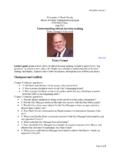Transcription of The Emerging Middle Class in Developing Countries
1 The Emerging Middle Class in Developing CountriesHomi Kharas, Brookings InstitutionJune XX, 20111 Introduction Middle Class consumers in the US and other G7 powers have been a key source of demand in the global economy for the last 50 years. But with weak expected growth in US and European consumption going forward, where will future global demand growth come from? The Middle classes in Emerging economies, especially in Asia We are reaching a tipping point, where over the next several years the global Middle Class will expand dramatically. This is one of the most important features of today s global economic is the Middle Class important for growth?
2 Income elasticities of demand greater than one (esp. durables) Kink in demand curves at PPP$6000 Preference for product differentiation leads to value added in branding Values (hard work, meritocracy, saving, education) Catalytic Class (economic policymaking, but not entrepreneurship) More sustainable than export-led growth; less risk of Middle income trap (Gill and Kharas 2007)3 Relative vs. absolute definitions Between the poor in Portugal/Italy and the rich in Luxembourg: $10 to $100 a day, 2005 PPP$ Calculate current population and spending of the Middle Class for 145 Countries accounting for 98 percent of global population and 99 percent of global GDP using data on distribution and mean consumption per capita in 2005 PPP$Defining the Global Middle Class44 The Global Middle Class TodaySize of the Middle Class , 2009(millions of people and global share)
3 5 Project GDP growth for 145 Countries using simple Cobb-Douglas growth model featuring catch-up for a set of rapidly converging economies, including China and India Assume no change in Middle of income distribution or in household expenditure share of GDP Most changes in Gini are dominated by changes in shares of top and bottom deciles, not the Middle Class (Palma 2007)Projecting the Evolution of the Global Middle Class6 Growth in Global GDP Accelerates, Driven by Asia7 The Economic Center of Gravity Shifts East8A Surge in the Global Middle Class -1,0002,0003,0004,0005,0006,0007,00 08,0009,00020002002200420062008201020122 01420162018202020222024202620282030 Population (millions)
4 PoorMiddle ClassRich9A Crossover from West to EastNorth America33818%33310%3227%Europe664 36%703 22%680 14%Central and South America181 10%251 8%313 6%Asia Pacific525 28%1,740 54%3,228 66%Sub-Saharan Africa32 2%57 2%107 2% Middle East and North Africa105 6%165 5%234 5%World1,845 100%3,249 100%4,884 100%200920202030 Size of the Middle Class , 2009 - 2030(millions of people and global share)10A Crossover from West to EastMiddle Class Consumption(billions of 2005 PPP$ and global share)North America5,602 26%5,863 17%5,837 10%Europe8,138 38%10,301 29%11,337 20%Central and South America1,534 7%2,315 7%3,117 6%Asia Pacific4,952 23%14,798 42%32,596 59%Sub-Saharan Africa256 1%448 1%827 1% Middle East and North Africa796 4%1,321 4%1,966 4%World21,278 100%35,045 100%55,680 100%20092020203011 India and China Make Waves in the Global Middle Class121 United States4,377 21%China4,468 13%India12,777 23%2 Japan1,800 8%United States4,270 12%China9,985 18%3 Germany1,219 6%India3.
5 733 11%United States3,969 7%4 France927 4%Japan2,203 6%Indonesia2,474 4%5 United Kingdom889 4%Germany1,361 4%Japan2,286 4%6 Russia870 4%Russia1,189 3%Russia1,448 3%7 China859 4%France1,077 3%Germany1,335 2%8 Italy740 3%Indonesia1,020 3%Mexico1,239 2%9 Mexico715 3%Mexico992 3%Brazil1,225 2%10 Brazil623 3%United Kingdom976 3%France1,119 2%200920202030 Middle Class Consumption Top 10 Countries (billions of 2005 PPP$ and global share)The New Big Spenders13A Closer Look at China s Middle Class Already the second largest Middle Class in absolute terms, at 157 million consumers (US is #1) But small in relative terms (only 12% of the population) Also small given its level of development, due to income inequality and (especially) small share of household expenditure in GDP By 2030 over 70 percent of China s population could be Middle Class , consuming nearly $10 trillion in goods and services14 China is on the verge of becoming a Middle Class nation0%10%20%30%40%50%60%70%80%90%100%1 00100010000100000 Annual income (2005 PPP$, log scale)
6 Cumulative percent of population200920202030$2/ day$5/ day$10/ day$100/ day15 China s Booming Middle Class0%10%20%30%40%50%60%70%80%90%100%Po orMiddle ClassRichShare of population20092020203016 How Can China Increase the Size of its Middle Class ? Address Inequality (current spatially adjusted Gini )? Important in the long term, but won t help Middle Class in the short term. Lower household savings rates? Perhaps desirable, but difficult to achieve (even the near poor save 17%). Will require significant institutional reform. Best policy response is to increase share of household income in GDP. Raise household consumption from 36 percent of GDP to at least 46 percent in the short run Aggressively use profits from SOEs to reduce taxes, increase social services Reduce labor taxes Address housing shortages17 Higher Consumption Accelerates the Rise of China s Middle Class0%10%20%30%40%50%60%70%80%90%100%20 0020022004200620082010201220142016201820 2020222024202620282030 Middle Class as Share of Total PopulationBaselineHigh Consumption Scenario18A Closer Look at India s Middle Class Small today (5% of population), but set to expand dramatically.
7 India could be the world s largest Middle Class consumer market by 2030, surpassing both China and the US. Between now and 2039, India could add over 1 billion people to the global Middle Expansion of India s Middle Class20 Conclusion The world is in the throes of a major expansion in the Middle Class , particularly in Emerging Asia. The global Middle Class is expected to grow from under 2 billion consumers today to nearly 5 billion within two decades. Middle classes are an important key driver of growth, as the income elasticity for durable goods and services for Middle Class consumers is greater than one. China and India are at the forefront of the expansion of the global Middle Class .
8 The world economy can be expected to increasingly rely on the Middle classes of these two Asian powers as key sources of global demand.















